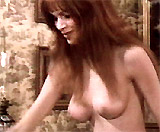
|
History of Sex in Cinema: Hammer Studios' Vampire Films |

The Karnstein Trilogy of Hammer Studios' Vampire Films: The Karnstein Trilogy consisted of the following three films:
Although Britain's Hammer Studios had already defined the period film from the late fifties on with its remakes of Universal horror films, the atmosphere changed with relaxed standards and ratings. The studio began to produce a series of low-budget, exploitative horror films in the early 70s. These films took advantage of the new morality,
and were characterized by deeply saturated color, bright-red
blood, gothic horror, suggestive
soft-core sex and graphic nudity, vampire brides, lesbian overtones,
plunging necklines, and a bevy of 'Scream Queen' stars such as Ingrid
Pitt. |
||||||||

|
The Vampire Lovers (1970, UK) This was a remake of director Roger Vadim's Blood and Roses (1961), the first openly lesbian vampire film. Vadim's film had previously been adapted by Carl Dreyer for his film Vampyr - Der Traum des Allan Grey (1932). This 1970 film was based on Carmilla, a novel by J. Sheridan Le Fanu, and was made by director Roy Ward Baker. It starred Polish actress Ingrid Pitt in her first film for Hammer. The MPAA declared the heavily-cut sexy vampire film R-rated, due to the erotic, sapphic-based nudity and vampire bites inflicted on female breasts. The film's poster declared: "IF YOU DARE...take the deadly passion of the BLOOD-NYMPHS." One of the story's three vampire hunters (in a small role) was:
The main vampire character was:
When her aunt Countess (Dawn Addams) was called away, Marcilla moved in to pursue, seduce, and possess the General's daughter:
Laura mysteriously grew pale and sickly and died from repeated vampire bites (an attending doctor noticed two small bite marks above her left nipple). Marcilla then chose her next victim to corrupt:
Marcilla took a bath in her bedroom and then after leaving the tub, she chased semi-naked after Emma around and onto a bed, after she had convinced her to untie her bodice. |
  Marcilla (Ingrid Pitt)  Laura Spielsdorf (Pippa Steel)   Emma Morton (Madeline Smith) |
||||||

|
Lust for a Vampire (1971, UK) (aka To Love a Vampire) After the success of The Vampire Lovers (1970), Hammer released this additional lesbian sexploitation erotic sequel with much more voluptuous, bare-breasted nudity. The publicity still for this masturbatory, Sapphic-tinged gothic fantasy-horror film was an exaggerated, graphic image of lesbian vampiress Carmilla 'Mircalla' Karnstein (revived and reborn as a younger and blonder version), and exhibiting a blood-drenched chest. The story was set In the year 1830. Carmilla (Danish blonde actress-model Yutte Stensgaard, replacing Ingrid Pitt from the first film) had been raised from the dead in a black magic ceremony conducted by Count Karnstein (Mike Raven) and Countess Karnstein/Herritzen (Barbara Jefford). They had sacrificed a kidnapped virginal maiden in a blood ritual, to resurrect Carmilla. She satisfied her bloodlust by posing as the niece of the Countess Herritzen, and enrolling in an exclusive and elite European girl's academy (finishing school) near the Karnstein castle, run by uptight Miss Simpson (Helen Christie) and her partner Giles Barton (Ralph Bates). It was filled with suitable nubile females to seduce, who often performed outdoor dancing exercises in see-through flowing drapes, or were topless in their bedrooms. In the meantime, horror writer Richard Lestrange (Michael Johnson) came to the village just below Castle Karnstein. He had become fascinated by the legend of the Karnsteins, and finagled his way into becoming an instructor/tutor at the school, where he became enamoured of Carmilla.
The horror film included:
|
  (l to r) Susan Pelley (Pippa Steel) with Carmilla   Amanda (Judy Matheson)  Schoolgirl (Sue Longhurst)  Schoolgirl |
||||||

|
Twins of Evil (1971, UK) (aka Twins of Dracula, The Evil Twins) Hammer Studio's erotic vampire film (with plentiful nudity and gore, but without the lesbian plot angle) was the final installment of the Karnstein trilogy. One of the film's posters posed the film's main plot-line - which was the evil twin?:
It was set in 17th century Austria and told about two orphaned, identical twins, pretty buxom sisters (October 1970s Playboy Playmate twin centerfolds):
The two orphaned twin nieces went to live with their oppressive and tyrannical witch-hunter Uncle Gustav Weil (Peter Cushing), the leader of a puritanical, wench-burning group known as the Brotherhood. They lived near the legendary Karnstein castle. In the film's plot, local nobleman/vampire and black magic practitioner Count Karnstein (Damien Thomas) had been transformed into a vampire. The Count seduced the amoral, sensual and lustful Frieda (the most wicked of the two twins). In front of a mirror, he told her:
At that moment, the dashing Count bit into her neck (and her twin simultaneously felt the bite from another location!). Frieda was reborn as a vampiress. She was lead to a shackled young female victim, whom she feasted upon, as the Count (with bloody fangs) laughed and watched lasciviously from nearby. Then later (in a scene at the 68 minute mark, sometimes edited from prints), Frieda seduced schoolteacher Anton Hoffer (David Warbeck), who thought she was his loving friend Maria. [Note: The film's major plot twist was that the Count had switched the twins - and Maria was about to be burned at the stake, while Frieda was in their bedroom.] Anton noticed that she didn't cast a reflection in a mirror - and realized he had been kissing Frieda. He was forced to fight her off with a small crucifix (which burned an imprint into her hand).
The film concluded with Anton rescuing Maria from burning by the Brotherhood (after she proved she wasn't a vampire by kissing a cross). Frieda was beheaded by her Uncle Weil - who was then killed by the Count, after which Anton pierced the Count's heart with a spear. Anton and Maria were happily reunited. |
 The Twins of Evil: Maria and Frieda  Count Karnstein with Frieda (Madeleine Collinson) |
||||||